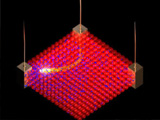|
|
TODAY.AZ / Weird / Interesting
Could a computer one day rewire itself?
27 October 2011 [14:08] - TODAY.AZ
 Scientists at Northwestern University have developed a new nanomaterial that can "steer" electrical currents. The development could lead to a computer that can simply reconfigure its internal wiring and become an entirely different device, based on changing needs.
Scientists at Northwestern University have developed a new nanomaterial that can "steer" electrical currents. The development could lead to a computer that can simply reconfigure its internal wiring and become an entirely different device, based on changing needs.As electronic devices are built smaller and smaller, the materials from which the circuits are constructed begin to lose their properties and begin to be controlled by quantum mechanical phenomena. Reaching this physical barrier, many scientists have begun building circuits into multiple dimensions, such as stacking components on top of one another.
The Northwestern team has taken a fundamentally different approach. They have made reconfigurable electronic materials: materials that can rearrange themselves to meet different computational needs at different times.
"Our new steering technology allows use to direct current flow through a piece of continuous material," said Bartosz A. Grzybowski, who led the research. "Like redirecting a river, streams of electrons can be steered in multiple directions through a block of the material -- even multiple streams flowing in opposing directions at the same time."
Grzybowski is professor of chemical and biological engineering in the McCormick School of Engineering and Applied Science and professor of chemistry in the Weinberg College of Arts and Sciences.
The Northwestern material combines different aspects of silicon- and polymer-based electronics to create a new classification of electronic materials: nanoparticle-based electronics.
The study, in which the authors report making preliminary electronic components with the hybrid material, will be published online Oct. 16 by the journal Nature Nanotechnology. The research also will be published as the cover story in the November print issue of the journal.
"Besides acting as three-dimensional bridges between existing technologies, the reversible nature of this new material could allow a computer to redirect and adapt its own circuitry to what is required at a specific moment in time," said David A. Walker, an author of the study and a graduate student in Grzybowski's research group.
Imagine a single device that reconfigures itself into a resistor, a rectifier, a diode and a transistor based on signals from a computer. The multi-dimensional circuitry could be reconfigured into new electronic circuits using a varied input sequence of electrical pulses.
The hybrid material is composed of electrically conductive particles, each five nanometers in width, coated with a special positively charged chemical. (A nanometer is a billionth of a meter.) The particles are surrounded by a sea of negatively charged atoms that balance out the positive charges fixed on the particles. By applying an electrical charge across the material, the small negative atoms can be moved and reconfigured, but the relatively larger positive particles are not able to move.
By moving this sea of negative atoms around the material, regions of low and high conductance can be modulated; the result is the creation of a directed path that allows electrons to flow through the material. Old paths can be erased and new paths created by pushing and pulling the sea of negative atoms. More complex electrical components, such as diodes and transistors, can be made when multiple types of nanoparticles are used.
The title of the paper is "Dynamic Internal Gradients Control and Direct Electric Currents Within Nanostructured Materials." In addition to Grzybowski and Walker, other authors are Hideyuki Nakanishi, Paul J. Wesson, Yong Yan, Siowling Soh and Sumanth Swaminathan, from Northwestern, and Kyle J. M. Bishop, a former member of the Grzybowski research group, now with Pennsylvania State University.
/Science Daily/
URL: http://www.today.az/news/interesting/97219.html
 Print version
Print version
Connect with us. Get latest news and updates.
See Also
- 19 February 2025 [22:20]
Visa and Mastercard can return to Russia, but with restrictions - 05 February 2025 [19:41]
Japan plans to negotiate with Trump to increase LNG imports from United States - 23 January 2025 [23:20]
Dubai once again named cleanest city in the world - 06 December 2024 [22:20]
Are scented candles harmful to health? - 23 November 2024 [14:11]
Magnitude 4.5 earthquake hits Azerbaijan's Lachin - 20 November 2024 [23:30]
Launch vehicle with prototype of Starship made its sixth test flight - 27 October 2024 [09:00]
Fuel prices expected to rise in Sweden - 24 October 2024 [19:14]
Turkiye strikes terror targets in Iraq and Syria - 23 October 2024 [23:46]
Kazakhstan supplied almost entire volume of oil planned for 2024 to Germany in 9 months - 23 October 2024 [22:17]
Taiwan reported passage of Chinese Navy aircraft carrier near island
Most Popular
 Radicals have invented new enemy for Iran
Radicals have invented new enemy for Iran
 Research Center: Peace agreement opens historic new page for S Caucasus
Research Center: Peace agreement opens historic new page for S Caucasus
 President Ilham Aliyev receives UK Minister of State for Europe and North America
President Ilham Aliyev receives UK Minister of State for Europe and North America
 Human remains discovered in liberated A?d?r? district
Human remains discovered in liberated A?d?r? district
 Court in Baku continues trial of Armenian-origin individuals accused of war crimes
Court in Baku continues trial of Armenian-origin individuals accused of war crimes
 ANAMA: Nearly 1,500 hectares made safe in demining push
ANAMA: Nearly 1,500 hectares made safe in demining push
 Expired ammunition to be destroyed in Pir?k??kül settlement
Expired ammunition to be destroyed in Pir?k??kül settlement
